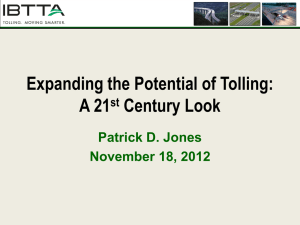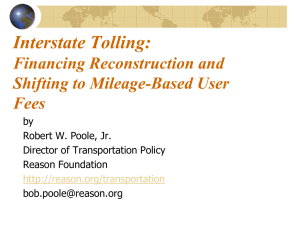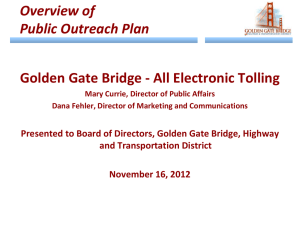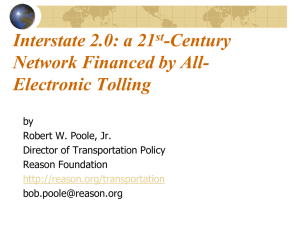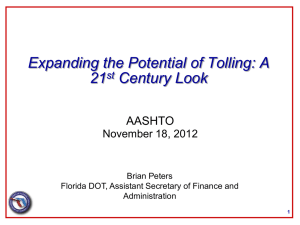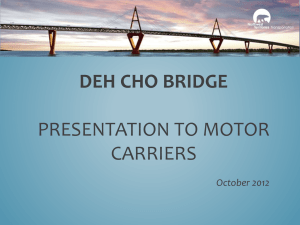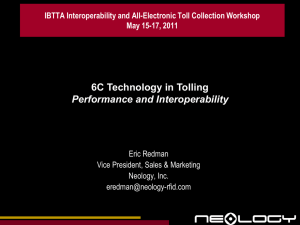Users` attitudes towards road tolls
advertisement
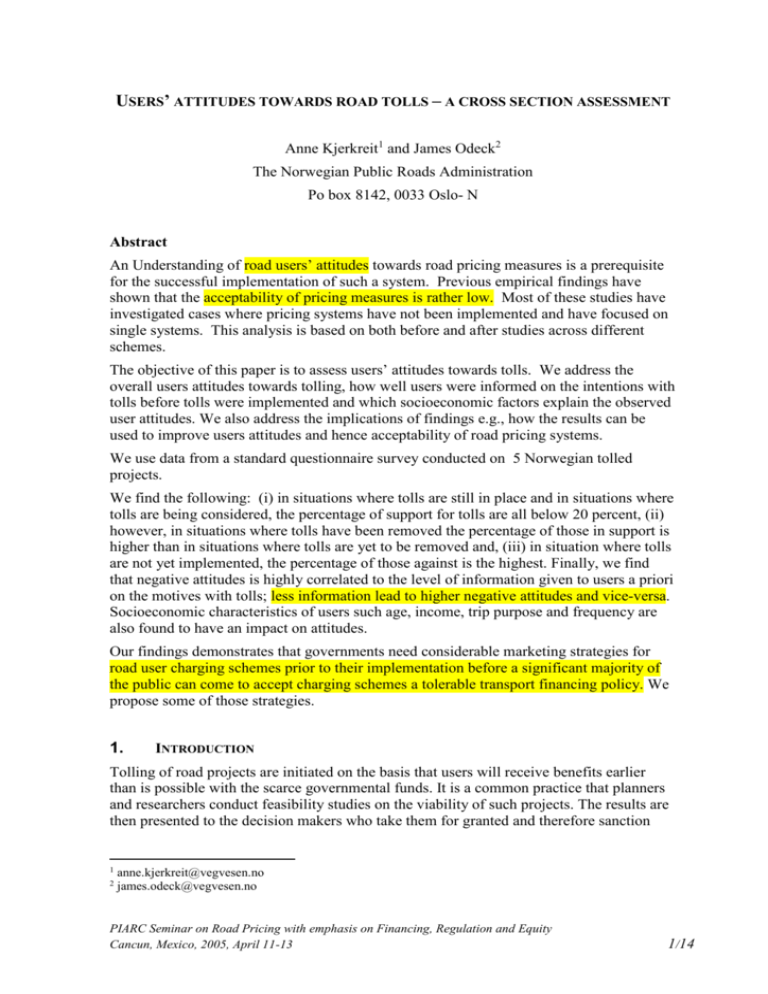
USERS’ ATTITUDES TOWARDS ROAD TOLLS – A CROSS SECTION ASSESSMENT Anne Kjerkreit1 and James Odeck2 The Norwegian Public Roads Administration Po box 8142, 0033 Oslo- N Abstract An Understanding of road users’ attitudes towards road pricing measures is a prerequisite for the successful implementation of such a system. Previous empirical findings have shown that the acceptability of pricing measures is rather low. Most of these studies have investigated cases where pricing systems have not been implemented and have focused on single systems. This analysis is based on both before and after studies across different schemes. The objective of this paper is to assess users’ attitudes towards tolls. We address the overall users attitudes towards tolling, how well users were informed on the intentions with tolls before tolls were implemented and which socioeconomic factors explain the observed user attitudes. We also address the implications of findings e.g., how the results can be used to improve users attitudes and hence acceptability of road pricing systems. We use data from a standard questionnaire survey conducted on 5 Norwegian tolled projects. We find the following: (i) in situations where tolls are still in place and in situations where tolls are being considered, the percentage of support for tolls are all below 20 percent, (ii) however, in situations where tolls have been removed the percentage of those in support is higher than in situations where tolls are yet to be removed and, (iii) in situation where tolls are not yet implemented, the percentage of those against is the highest. Finally, we find that negative attitudes is highly correlated to the level of information given to users a priori on the motives with tolls; less information lead to higher negative attitudes and vice-versa. Socioeconomic characteristics of users such age, income, trip purpose and frequency are also found to have an impact on attitudes. Our findings demonstrates that governments need considerable marketing strategies for road user charging schemes prior to their implementation before a significant majority of the public can come to accept charging schemes a tolerable transport financing policy. We propose some of those strategies. 1. INTRODUCTION Tolling of road projects are initiated on the basis that users will receive benefits earlier than is possible with the scarce governmental funds. It is a common practice that planners and researchers conduct feasibility studies on the viability of such projects. The results are then presented to the decision makers who take them for granted and therefore sanction 1 2 anne.kjerkreit@vegvesen.no james.odeck@vegvesen.no PIARC Seminar on Road Pricing with emphasis on Financing, Regulation and Equity Cancun, Mexico, 2005, April 11-13 1/14 tolling on that basis. In the process, roads users are often ignored at least as far as their attitudes are concerned. The failure to involve users in the planning process by for example informing them before hand on the intentions with tolling and how benefits will accrue to them may explain why some planned charging schemes have failed in the past. The rationale is clear; decision makers will be more likely to sanction projects that the users are in support of. Ideally road users should understand and support tolling as it brings forth benefits at an earlier stage than would be possible with state funds alone. If people really understand the reason for tolling, people might be more positive towards tolling and make it easier to sanction toll projects for the politicians. In this paper we address what the user attitudes towards tolling are, and whether users understand and appreciate the ideas behind tolling. We use Norway as a case example, where tolling has been practised for over 60 years. Our point of departure is a questionnaire survey conducted at five different toll projects. Specifically we consider whether users really understand the assumptions made by planners and experts; do they know or acknowledge that tolling is for their own benefit? A special emphasis is set on how information influences the attitudes towards tolls. Other explanatory factors for the prevailing attitudes are also investigated. There is a growing literature on users’ attitudes towards toll and road pricing in particular(see for instance, Jones 1991, 1995 and 1998 and Schade and Schlag (2003) where they conduct a wide literature review). However, most of this literature has dealt with attitudes towards tolling prior to the implementation of tolls. For the Norwegian case in particular, there are several studies that have examined attitudes towards road tolls. Odeck and Bråthen (1997, 2002) examined the changing users’ attitudes towards the Oslo toll ring from 1989 to 1995 and found that users became more and more positive towards the tolls as the benefits of tolls accrued to them through better infrastructure. Odeck and Bråthen (2004) give an overview of the toll systems and their expected development in the future. In this study we analyse attitudes in situations before and after implementation of toll charging systems. The remaining part of this paper is organised as follows: Section 2 provides the description of data and methodology, Section 3 presents the empirical results and Section 4 the concluding remarks. 2. THE DATA AND METHODOLOGY Data was collected from 5 different toll projects with different characteristics, and situated in different regions. Table 1 gives an overview of the projects studied. Two of the studies (E6 Leirfjorden and E18 Lierbommen) were conducted after the toll charging scheme had been removed and the new road already was financed and built. In two studies (E18 and E6 Østfold), the toll charging scheme had just been introduced and the road construction was in progress. In the last study (Tønsbergpakken), the toll charging scheme was yet to be implemented, but the scheme was already sanctioned by the parliament to start the following year. PIARC Seminar on Road Pricing with emphasis on Financing, Regulation and Equity Cancun, Mexico, 2005, April 11-13 2/14 Table 1: The characteristics of the project: Name of project Type of toll scheme E18 Østfold Single toll Yes1 Tolls just implemented E6 Østfold Single toll No Tolls just implemented E18 Lierbommen Single toll Yes Tolls just removed E6 Leirfjorden Single toll No Tolls just removed Tønsbergpakken Toll Ring No Tolls about to be implemented 1 Availability of alternative toll free route Status of toll charging Alternative road in only one direction Data was collected by means of a standard question survey of roads users. Questions raised to the respondents addressed issues of public concern about the imposition of tolls. The data collected was analysed in the two following ways: 1. A descriptive analysis with respect to attitudes, information and understanding of tolling. 2. A multivariate analysis where attitudes are related to the overall characteristics of the individuals as well as the information and understanding of tolls. About 21000 responses were received, however not all respondents responded to all questions. One of the studies (Leirfjorden) had only questions about attitudes and not about information or understanding of tolls and is therefore only included in the analysis of general question about attitudes. The multivariate analysis was built on a binary probabilistic model (see Ben-Akiva and Lerman 1987 for description) because of the discrete nature of the two possible outcomes of attitudes. The question posed to the respondents about their attitudes was classified as positive or negative. This is the same as a discrete choice situation where people choose to be negative or positive. Logit-, probit and other limited dependent variable models could all be chosen to model this choice situation. For the sake of convenience, a binominal logit model was chosen. This model can in general form be written as: Pij = e Vij ∑e Vij j Where Pij is the probability that respondent i choose to have j as an attitude. Vij is the respondent’s satisfaction by choosing attitude j and is written as: PIARC Seminar on Road Pricing with emphasis on Financing, Regulation and Equity Cancun, Mexico, 2005, April 11-13 3/14 Vij = X ij + ij Where: Xij= a vector of measurable characteristics that define utility, (e.g. age, gender, income, trip frequency, information, etc.); ß= a vector of parameters to be estimated and ij = an error term that accounts for unobservable factors influencing individuals’ utility choosing attitude type j. In the model, all variables are categorical; hence only statements about the effect of a particular category in comparison to some other categories can be drawn. For example, in this analysis the estimated “information 1” parameter represents the influence “too little information” (information 1) has on attitudes in comparison to “sufficient information”. This is explained further under the description of the estimated model. 3. EMPIRICAL RESULTS The findings from this study are divided in two: (1): attitudes towards tolls and how the level of information received influence attitudes (2) how overall characteristics of individuals influence their attitudes towards tolls. 3.1 Attitudes towards Tolls and Influence of Information and Understanding of Tolls Knowledge about user’s attitudes towards tolling and factors affecting it is important for those who make decisions on whether to finance projects with tolls or not. An interesting question to address is if and how attitudes vary. Table 2 shows the variation in attitudes towards tolls across the 5 projects studied. Table 2: Attitudes towards tolling Toll project Time of study Positive (%) Negative (%) Observations E18 Østfold Tolls just introduced 14 86 785 E6 Østfold Tolls just introduced 19 81 2293 Tønsbergpakke Tolls about to be introduced 11 89 11865 E18 Lierbommen Tolls removed 32 68 5006 E6 Leirfjorden1 Tolls removed 75 25 893 30 70 20842 Weighted average 1 The question posed about attitudes to respondents was to what degree the respondent found tolling useful. Useful is interpreted as positive and not useful is interpreted as negative. PIARC Seminar on Road Pricing with emphasis on Financing, Regulation and Equity Cancun, Mexico, 2005, April 11-13 4/14 The vast majority (70%) are negative towards road tolling. This is not surprising, considering the fact that the people in principle are accustomed to free use of roads. Few will be positive to paying for a service that prior was free! The results indicate the following: 1. People are most negative towards tolling in places where tolls were yet to be introduced. In Tønsbergpakken, 89% was negative towards tolling. At E18 Lierbommen and E6 Leirfjorden, projects where tolling has been removed, 68% and 25% were negative towards tolls respectively. 2. In projects where the tolls have just been introduced (E6 and E18 Østfold), people are more negative towards tolls than where the toll charging has been removed 3. Users of projects where a fast link replace a ferry tend to be more positive towards tolling than users of other road projects. In the E6 Leiirfjorden case, 75% are positive. The reason for why people are most positive in situations where tolls have been removed is most likely that the users have seen the results and benefits of the toll charges. Users of roads where tolls have just been introduced have not experienced the full benefits of the charging scheme (e.g. E6 Østfold and E18 Østfold) and hence are a bit more negative. In situations where tolls have not yet been implemented, people have not even seen the start of the construction work and are more negative towards tolling. This is similar to the findings in Odeck and Bråthen (1997), where the attitudes toward the toll ring in Oslo became more positive as the benefits of the tolling arouse. It the Leirfjorden case the toll charges were used to build a road in replacement of a ferry. The benefits of the new road project was most likely more clear in comparison to the other tolled projects and probably considered to by large by the users. The users were used to paying a ferry fee before toll charges were introduced. A great demand and requirement locally for a new road in this area may also be the reason for why the majority of the users are positive to the toll fees. The findings make it tempting to conclude that to increase the acceptance of tolling: It is important to carefully explain the benefits of the tolls before the implementation of tolls The transport problem to be solved by the tolled project is obvious and clear to the users. In a well functioning planning process, all involved parties should be informed; both users and decision makers alike. An important question is then to what extent users feel they were informed about the objective of the project and tolling before it was implemented. If they have been well informed, it is possible they will be more positive towards tolling, since they would know they are paying for the infrastructure they most likely will be using in the future. In the following, the extent of information received by users on the intentions with tolls and how this might influence attitudes is analysed. Table 3 shows to what extent the users feel they have received enough information about the use of tolls and alternatives to tolls. PIARC Seminar on Road Pricing with emphasis on Financing, Regulation and Equity Cancun, Mexico, 2005, April 11-13 5/14 Table 3: Level of information at the different toll projects Very little (%) Little (%) Adequate (%) Much (%) Too Much (%) E18 Østfold 22 31 35 9 2 E6 Østfold 22 33 35 9 2 Tønsbergpakken 19 31 38 10 2 E18 Lierbommen 21 32 40 6 1 Total 21 31 37 8 2 A clear indication is given from the results; the users of the toll projects are not given sufficient information about the reason for toll charging and alternatives to toll charging. On average, only 37 % thought that they received adequate information, and only 47% thought they received adequate or more than adequate information about the reason for toll charges. As much as 52 % think they have received less than adequate information! Another issue worth consideration is if the level of information influences the attitudes towards tolling. Figure 1 show how positive and negative users categorise the level of information received. Figure 1: Percent of positive and negative attitudes by level of information The result indicates that the level of information influence the attitudes towards tolling. People who have received adequate information tend to be more positive towards tolling than people who have not received adequate information. PIARC Seminar on Road Pricing with emphasis on Financing, Regulation and Equity Cancun, Mexico, 2005, April 11-13 6/14 66 % of the respondents that are positive towards tolls have received adequate or more than adequate information. Only 45 % of the respondents who are negative towards tolls mean they have received adequate or more than adequate information. 55 % of the users with negative attitudes towards tolling feel they have received less than adequate information about the tolling at the same time as a higher percentage of the positive ones have received sufficient information. This makes it tempting to conclude with the following: There is a great need for information about the reasons for tolling and alternatives so that people understand what the potential benefits of financing by tolling are. By improving the information strategy, planners might receive more support for tolling as a mean to finance the project. The objective of tolls in Norway is to raise funds for road infrastructure. Tolls bring forth benefits at an earlier stage than would be possible with governmental funds alone. Do people understand the reason for tolling? What do they believe is the reason for toll charges? Table 4 shows why the users think toll charges have been/is introduced Table 4: Reasons for tolling Environmental initiative to reduce traffic growth (%) More money for the government (%) Financing a Better Road System (%) E18 Østfold 0 31 69 E6 Østfold 1 33 66 Tønsbergpakken 5 28 67 E18 Lierbommen 1 30 69 Total 3 29 68 There seem to be no large difference between projects on what the users believe is the reason for tolling. On average, 68 % believe financing a better road system is the reason for tolling, 29 % thinks “More money to the government” is the reason and 3% think tolling is an environmental initiative to reduce traffic. Although it should be encouraging for road planners that the vast majority understand the reasons with tolling, there is still work to be done in terms of informing users. An interesting question to look at is whether there is a difference between people with positive and negative attitudes with respect to what they believe is the intentions with tolling. PIARC Seminar on Road Pricing with emphasis on Financing, Regulation and Equity Cancun, Mexico, 2005, April 11-13 7/14 Table 5: Attitudes and the reason for tolling Environmental initiative to reduce traffic growth (%) More money for the government (%) Financing a better road systems (%) Positive 4 7 89 Negative 3 34 63 An interesting finding is that when comparing users with positive attitudes to users with negative attitudes, a higher percentage of the users with positive attitudes towards tolling know that the intention with tolling is to finance a better roads system. 89 % of the positive respondents believe the reason is to finance better roads systems, whereas 63% of the ones with negative attitudes believe the same. Thus, we are tempted to conclude that appropriate information probably will help increase positive attitudes towards tolls. An understanding of the reason for attitudes might be of help when designing information to the users. The questionnaire made it possible to see how the respondents themselves explain their negative and positive attitudes. Table 6: Explanations of negative attitudes Explanations % Expensive way of collecting money 9 Money is used for other things than building roads 11 People are obstructed from travelling 2 The toll plaza is never removed 3 We already pay enough in taxes 75 The main reason (75 %) for the negative attitudes is that people think they already pay enough taxes. This is not surprising. A national road tax is levied on the car users. In addition the car users face taxes on the purchase and use of cars. Some of these taxes (The CO2 and SO2 tax) are taxes to internalise environmental impacts of using fuel, whereas the others are general taxes. Planners do not have the possibility to change the level of general taxes; however they are in the position to use this information in a strategy for implementing tolls. On average a surprisingly high share (11 %) of the respondents think that the money is used for other things than building roads. In the Lierbommen survey, as many as 18 percent of the users are negative because they believe the money is used for other things than improving the road system. Lierbommen is however, a special case where the toll plaza was not removed after the road project had been built and fully financed. The toll funds were also used to finance another road project which was not directly beneficial to all users. This indicates that it is important that tolls benefits the direct users. Some of the users are negative towards tolling because they think that toll chaging is an expensive way of collecting funds. In Norway the cost of collection toll funds vary with the charging system. For instance, in Tønsbergpakken, a fully automatic charging system PIARC Seminar on Road Pricing with emphasis on Financing, Regulation and Equity Cancun, Mexico, 2005, April 11-13 8/14 has been built. Some other toll plazas have lanes where users can pay manually while there are optional lanes for tag users. On average the cost of collecting toll funds within projects in Norway is about 10% of the total funds collected. An alternative to financing new roads by tolls would be to finance projects with general taxes. This is not cost free either and needs to be explained to road users! In Norway the cost of funds is set to 20 % by the Ministry of Finance and reflects the administrative and distortion costs associated with collecting funds through taxation. Thus, tolls may in some instances be considered as a cheaper way of financing infrastructure especially where the additional deadweight loss, which should be added to collection costs, is less than 10 %. A low percentage of users, about 2 %, state that “the toll fees obstruct people from travelling” as reason for being negative towards tolls. It thus seems as if tolls have relatively low elasticity. In fact, this finding conform to previous studies on toll elasticities which have shown elasticities to vary between 0.3 and 0.8 (See for instance, Goodwin 1992, and Odeck and Bråthen 2004) Table 7 shows how the respondents explain their positive attitudes. The majority, about 72 %, are positive towards tolling because it gives them a better road system. The benefit from paying is thus the reason for being positive. A quite large percentage (21%) is positive because the users of the road are paying themselves, which might indicate that paying for a benefit you will receive yourself is positive. Paying tolls for something you will not receive the benefits from is negative (ref table 6). Table 7: Stated reasons for positive attitudes (%) Financing a better road system 72 The users pay themselves 21 People are forced to travel by public transport and the environment is thereby improved 5 Others pay road tolls- why not us? 2 3.2 How overall characteristics of individuals influence their attitudes towards tolls We now turn to analyse the determinants of attitudes towards tolls using a multivariate logit analysis, where we combine factors described above with overall characteristics of respondents as explanatory variables. Table 8 shows the variables in the model. The 0 categories are the reference category which the estimated parameters are compared to. PIARC Seminar on Road Pricing with emphasis on Financing, Regulation and Equity Cancun, Mexico, 2005, April 11-13 9/14 Table 8: Variables in the model Variables Attitude Information Understanding Age Income Gender Trip frequency Trip length Codes 1: Negative; 0: positive 1: Too little information; 0 otherwise: sufficient or more than sufficient information 1: Tolls are used to reduce traffic/tolls are there to increase the money to the government in general; 0 otherwise: toll charging is implemented to finance an improved road system 1: under 25 years, 2: 25-44 years, 3:45-64 years; 0 otherwise: > 64 years 1: under 150’ NOK, 2: 150’-300’NOK, 3: 301’-500’ NOK; 0 otherwise: >500’NOK 1: Man; 0 otherwise: Woman 1: >7 times a week, 2: 4-7 times a week, 3: 1-3 times a week, 4: 1-3 times a month, 5: 4-8 times a year; 0 otherwise: less than 4 times a year 1: < 5km, 2: 5-19 km, 3: 20-50km; 0 otherwise: > 50 km The result of the estimation is presented in Table 9. In the model, variables with positive signs should be interpreted as having a negative impact on attitudes and those with negative signs a positive impact. As mentioned earlier, an estimated parameter (here e.g. information (1)), represents how one category of information influence attitudes in comparison to another information category. If the estimated parameter is positive, it will mean that this group has a higher probability of being negative towards tolling than people in the reference category. If the estimated parameter is negative, it will mean that they have a lower probability of being negative. PIARC Seminar on Road Pricing with emphasis on Financing, Regulation and Equity Cancun, Mexico, 2005, April 11-13 10/14 Table 9: Results of the model Variables B S.E. df Sig. Information(1) ,697 ,043 1 ,000 Understanding(1) 1,301 ,060 1 ,000 Gender(1) -,073 ,045 1 ,106 3 ,000 Income Income(1) ,284 ,120 1 ,018 Income(2) ,386 ,060 1 ,000 Income(3) ,309 ,047 1 ,000 3 ,002 Age Age(1) ,487 ,140 1 ,000 Age(2) ,241 ,080 1 ,003 Age(3) ,226 ,078 1 ,004 3 ,000 Trip length Trip length(1) ,592 ,086 1 ,000 Trip length(2) ,610 ,057 1 ,000 Trip length(3) ,221 ,054 1 ,000 5 ,000 Frequency Frequency(1) ,539 ,100 1 ,000 Frequency(2) ,580 ,082 1 ,000 Frequency(3) ,246 ,086 1 ,004 Frequency(4) -,003 ,087 1 ,972 Frequency(5) -,014 ,101 1 ,885 Constant -,053 ,115 1 ,644 R2= 0,09 The first issue to address is whether the level of information received by the users significantly influence attitudes towards tolling. Users who received too little information (information (1)) had a higher probability of being negative than users who had been given sufficient or more than sufficient information. This indicates the importance of supplying sufficient information as a means of combating negative attitudes. Results from earlier sections in this paper, where a higher percentage of users who received sufficient or more than sufficient information were positive than those who received too little information, is verified. Next, to what degree people truly understand the intentions of tolling and how this influences the attitudes is of interest. Here, only people who stated that the reason for tolling is “to finance a better road system” were coded to have understood the intention with tolling. The result shows that understanding of tolling is a significant explanatory PIARC Seminar on Road Pricing with emphasis on Financing, Regulation and Equity Cancun, Mexico, 2005, April 11-13 11/14 variable. People who misunderstood the reason for tolling had in other words a higher probability for being negative towards tolling than people who understood the reason. In an information strategy, it is thus important to design the information in such a way that the intention with tolling is easy to understand. This might change negative attitudes. There seem to be no difference in attitudes with respect to gender. Gender is not a significant explanatory variable for attitudes. Looking closer at the influence income has on attitudes; we see that income is a significant explanatory variable. People in the lower income group have a higher probability for being negative towards tolling than people in the group with the highest level of income (more than 500’ NOK). This seems plausible; the higher income group will be less affected by the tolls since their budget in total is bigger. Table 9 also shows that the two medium income groups tends to be more negative than the lowest income group, all compared to the highest income group. In terms of age groups, the youngest car users seem to be the most negative towards tolling. This is a surprise as one might expect this age group to be more flexible in their travel behaviour when compared to older age (old habits are difficult to change). There is also a difference in attitudes with respect to the length of trip and trip frequency. The model shows that users who do the shortest trips are more likely to be negative as compared to those who do the longest trips. The total cost of a short trip will be more affected by the introduction of tolling compared to the cost of a long trip; hence people who do short trips are more likely to be negative towards tolling. Respondents who travel frequently has a higher probability for being negative than people with the lowest trip frequency; the more often you pass the toll ring, the more you will be affected by the toll charges. It is thus important that especially these groups understand and see the benefits of tolling. Note that the parameters for the frequency groups 4 and 5 are not significant. One might also expect attitudes to vary with travel purpose. However, travel purpose was not included in the model, since trip frequency and travel length would explain much of the same as travel purpose. These findings show that attitudes vary with the level of information, understanding of tolling and the overall characteristics of the respondents. For policy makers, our results can be used in a marketing strategy for toll financing. A marketing strategy should involve informing the public a priori on why roads are financed by tolls and which other options are available. The information should target the lower income groups, younger people and groups that travel frequently. 4. IMPLICATIONS OF FINDINGS AND CONCLUSION The above findings lead us to conclude that planners need to take the road users seriously when planning tolls. It is important to inform the users about the intention and benefits of tolls ex ante. This because most road users are negative towards tolls and the fact that it is a tendency for people to be more positive towards tolling as the benefits of tolling arises. The findings indicate that: When tolls have been collected for some time and has been removed there is a tendency for the users to be more positive towards tolling (E.g. E18 Lierbommen and E6 Leirfjorden). An explanation may be that people become positive when they PIARC Seminar on Road Pricing with emphasis on Financing, Regulation and Equity Cancun, Mexico, 2005, April 11-13 12/14 see that the tolls actually are used to build new and better roads to their own benefit. Once tolls have been implemented and road works are started (e.g. Østfold E6 and Østfold E18), people will over time understand the reason for tolling, and people will tend to be more positive towards tolling than in situations where the toll plazas is yet to be introduced. In situations where tolls are to be implemented, people tend to be more negative towards tolling compared to where the tolls have been removed. A reason for this might be that they do not foresee the benefits of tolling prior to the implementation and hence consider the tolls just as an extra tax levied on them. People tend to be more positive towards tolling in a situation where the tolls have been used to solve a very clear/apparent transport (e.g. E6 Leirfjorden) In a situation where people are accustomed to paying for transport in some ways (e.g ferry), people tend to be more positive towards tolling (e.g. E6 Leirfjorden). This can also be explained by high local pressure to see this kind of projects to be realised. The survey has identified different points of importance in a marketing strategy to gain acceptance for toll charging schemes: 1) Make the public aware of the intentions for tolls ex ante and carefully explain which problems will be solved, the construction costs, the opening date and the benefits to the users 2) Explain the advantages of toll schemes in relation to other options, e.g government funds which may be available in unforeseen future or not available at all. The cost and benefits of each options or alternative should be clearly explained. As an example, a high percentage of road users in this study believe that collecting tolls are expensive. Using government funds (tax revenue) has also a cost which should be compared to the cost of collecting tolls, and explained to them. 3) Target specific groups in the marketing strategy. Attitudes vary with respect to social-economic characteristics, which mean that tolling affect various groups differently. The information strategy should be designed so that particularly groups which are more likely to be negative towards tolling truly understand the intentions and benefits of tolling. 4) Equity considerations should be addressed. The ones passing the toll plazas frequently are the most affected by the toll charges and are more negative towards tolling than the less frequent drivers. The lower income groups will also be more affected. Politicians need to be aware of the equity aspect of the charging schemes. Support could be gained by giving the most frequent travellers discounted fares. At the same time, these frequent travels will eventually cause congestion and the pressure for new roads. Considering efficiency, a better solution would in principle be to give them lump sum compensation. This would though be practical difficult. A second best solution would be to introduce a cheaper and more frequent public transport system. PIARC Seminar on Road Pricing with emphasis on Financing, Regulation and Equity Cancun, Mexico, 2005, April 11-13 13/14 5) Involve the public already in the planning process. This might increase the awareness towards tolling also before the implementation of tolling and hence increase the acceptance. There is no reason to believe that users fully will be accepted by users since tolling will mean more taxes. Still it is important to focus on information in the planning process to get the best result. REFERENCES Ben Akviva, M and Lerman S R (1987), Discrete Choice Analysis: Theory and Application to Travel Demand. The MIT Press, Cambridge, Massachusetts 0214 Goodwin, P.B (1992): A review of new demand elasticities with special reference to short and long run effects of price changes. Journal of Transport Economics and Policy, XXV1 (2), pp 155-163 Jones P (1991). Gaining public support for road pricing through a package approach. Traffic Engineering and Control, (4) pp 194 –196 Jones P (1995). Road Pricing: The public viewpoint. In: B Johansson and LG Mattson (eds). Road Pricing. Theory, Empirical Assessment and Policy. Boston: Kluwer, 159-180 Jones P (1998). Urban road pricing: Public acceptability and barriers to implementation. In: KJ Button and ET Verhoef(eds.). Road Pricing, Traffic Congestion and The Environment. Issues of Efficiency and Social Feasibility. Edward Elgar Publishing, 263284 Odeck, J and Bråthen S (1997): On public attitudes toward implementation of toll roadsthe cas of Oslo toll ring. Transport policy, 4 (2) pp. 73-83 Odeck J and S Bråthen (2002). Toll financing in Norway: The success, the failures and perspectives for the future. Transport policy, 9 (4) pp 253 –260 Odeck J and Bråthen S (2004): Travel demand Elastcities and user attitudes. Working paper (2004:2). Møre Research, Schade J and B Schlag (eds)(2003). Acceptability of transport pricing strategies. Pergamon, Amsterdam. PIARC Seminar on Road Pricing with emphasis on Financing, Regulation and Equity Cancun, Mexico, 2005, April 11-13 14/14
